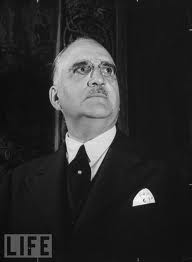Enrique Ruiz Guiñazú facts for kids
Enrique Ruiz Guiñazú (born October 14, 1882 – died November 13, 1967) was an important politician from Argentina. He is best known for being the Minister of Foreign Affairs, International Trade and Worship during the 1940s. This means he was in charge of Argentina's relationships with other countries.
His daughter is Magdalena Ruiz Guiñazú, who became a famous writer and journalist in Argentina.
Contents
Early Life and Career
Before becoming a diplomat, Enrique Ruiz Guiñazú worked as a professor and a banker. He then joined the diplomatic service, which is like working for the government to represent your country in other nations.
He held several important roles, including being the main representative for Argentina at the League of Nations. This was an international group that tried to keep peace after World War I. He also served as Argentina's ambassador (a country's official representative) to Switzerland.
Becoming Foreign Minister
When he was the ambassador to the Vatican City (a small, independent state within Rome, Italy), the President of Argentina, Ramón Castillo, called him back home. President Castillo wanted him to become the new Foreign Minister.
Even before the United States joined World War II, some people in the US thought Ruiz Guiñazú was too friendly with leaders who believed in fascism. Fascism was a type of government where a strong leader and military controlled everything, often with strict rules and no opposition. He often praised leaders like Benito Mussolini of Italy and Francisco Franco of Spain. An American diplomat named Sumner Welles even wrote that Ruiz Guiñazú was "one of the stupidest men" to hold office in Argentina.
Ruiz Guiñazú had been an ambassador to Spain, where he was impressed by a political idea called falangism, which was a Spanish form of fascism. As Foreign Minister, he believed Argentina should stay neutral in World War II. This meant not taking sides with either the Allied Powers (like the US and UK) or the Axis Powers (like Germany, Italy, and Japan). He also supported Hispanidad, an idea about the cultural connection between Spain and Latin American countries.
Actions During World War II
In January 1942, a big meeting of American countries was held in Rio de Janeiro, Brazil. Ruiz Guiñazú attended this Pan-American conference. At the meeting, the United States wanted all countries to agree to stop their diplomatic relations with the Axis Powers.
Ruiz Guiñazú pushed for a change in the agreement. Instead of a strong 'commitment' to break off relations, he made sure the wording was changed to a 'recommendation'. This meant countries were only advised to do it, not forced. Because of this, President Castillo kept Argentina's relations with Germany, Japan, and Italy open for his entire time as president.
Working with the Axis Powers
Ruiz Guiñazú and his main advisor, Mario Amadeo, worked closely with the Axis powers. They seemed to be looking for a way to make peace. They sent their own special envoy, Juan Carlos Goyeneche, to Europe. They also asked the German ambassador, Edmund von Thermann, to send their ideas for a peace meeting to Joachim von Ribbentrop, who was Germany's Foreign Minister. In their plan, Nazi rule over Europe would be officially recognized.
However, these ideas for a peace settlement did not work out. Ruiz Guiñazú's time as Foreign Minister ended in 1943.
Historian and Writer
Outside of politics, Enrique Ruiz Guiñazú was also a respected historian. In 1916, he wrote a book called La Magistratura Indiana. For many years after it was published, this book was considered a very important study of how justice worked in Latin America when it was under Spanish rule.
See also
 In Spanish: Enrique Ruiz Guiñazú para niños
In Spanish: Enrique Ruiz Guiñazú para niños


